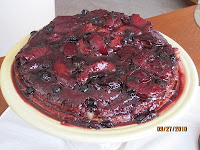 My husband usually sharpens my knives for me and does a great job. I have made a few mistakes and have actually cut myself. Everyone does this from time to time...I have learned a few pointers and wanted to share them with you....in case you didn't know.
My husband usually sharpens my knives for me and does a great job. I have made a few mistakes and have actually cut myself. Everyone does this from time to time...I have learned a few pointers and wanted to share them with you....in case you didn't know.Did you know a sharp Knife is actually safer than a dull one. Dull knives are more likely to slip off foods, resulting in cut fingers. The preferred equipment for sharpening knives is a whetstone. which takes some practice to master. A grinding wheel or electric knife sharpener can restore and a sharpening steel keeps the edges in alignment. If you have a problem keeping an edge on your knife it may mean that you are not using the steel as frequently as you should. You may have to use a grinding tool, such as a wheel or an electric sharpener to restore the edge. Once your knife is sharp, run both sides of your knife along the sharpening steel at a 20 degree angle before each and every use: wipe off the blade on a clean towel to remove any metal fragments.
The two best places to store your knives are a magnetic rack or in a wooden counter top knife block. Never store them in a drawer with other utensils. Not only do you risk injury, but knife blades may become nicked and dented beyond repair.
The four basic knives to own are a chef knife (also called a French knife) for chopping and julienning, a paring knife, a slicing knife and a boning knife. Additional knives you may want include a serrated knife for slicing bread, a cleaver, a fish filleting knife and a pair of kitchen shears.
So know you know.... Be careful, pay attention when you are cutting and keep your knives sharp.





















